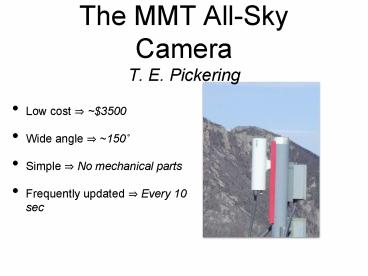The MMT AllSky Camera T. E. Pickering - PowerPoint PPT Presentation
1 / 13
Title:
The MMT AllSky Camera T. E. Pickering
Description:
Low-noise, variable gain video camera. On-board integration up to 256 frames ... Images are archived into DivX format AVI files at sunrise and sunset each day. ... – PowerPoint PPT presentation
Number of Views:76
Avg rating:3.0/5.0
Title: The MMT AllSky Camera T. E. Pickering
1
The MMT All-Sky CameraT. E. Pickering
- Low cost ? 3500
- Wide angle ? 150
- Simple ? No mechanical parts
- Frequently updated ? Every 10 sec
2
Camera Hardware
3
Computer Hardware
Fiber-isolated Video and RS232 ? Need optical
isolation to protect against lightning ? TeleByte
duplex RS232 fiber modems ? Luxcom OM-7 video
fiber modems ? Better video quality than long run
of coax
Framegrabber FlashBus MV PCI ? Color with lower
noise monochrome mode ? Linux driver and SDK
available
Computer Shuttle SFF PC ? 2.8 GHz Celeron w/1
GB RAM ? Nothing special, just need PCI slot and
enough RAM for movies
4
Software
- FlashBus SDK from Integral Technologies used to
build tools for grabbing and averaging frames
into FITS images. - Open source ImageMagick tools used to convert
FITS images to GIF and PNG, apply markup to
images, and to create animated GIFs. An animated
GIF of the 100 most recent frames is created
whenever a new image is acquired. - No automatic gain or exposure control on camera
so master control script must monitor image
brightness and adjust camera parameters
accordingly. During the day the automatic iris
control is sufficient and works well. - Images are archived into DivX format AVI files at
sunrise and sunset each day. This format allows
us to compress 4000 images (1.2 GB) into
single 12-20 MB files while retaining good image
fidelity.
5
How does it do?
Pretty good during the day....
6
Pretty darn good at night....
7
Can easily see clouds in the dark....
8
Handles the bright moon reasonably well....
9
Catches meteors, satellites, and zodiacal
light....
10
Sometimes there are surprises....
11
Calibrating Image Coordinates
- In the images shown, the red cross denotes the
pointing position of the MMT. - First step is to find zenith point in image and
convert (x,y) to (r,?) within image. - Then it is easy to map azimuth onto ? (we use
just a zeropoint offset) and zenith angle onto r
(we fit a cubic polynomial).
12
Radial Distortion in Lens
RMS about the full geometric transformation is
1.2 pixels
13
In Summary...
- Our system is pretty cheap The capital cost of
the equipment was less than 3500 and the
software requirements are fairly simple. - Our system is robust It has operated almost
without hitch for the past 8 months. - Our system is sensitive At night with a maximum
8.53 sec exposure and a moderate gain setting the
system can easily reach 5th mag or fainter in the
visual. - Rapid response comes in handy The 10 sec duty
cycle provides nearly continuous temporal
coverage. This is helped catch light
precipitation that might otherwise have gone
unnoticed. - See http//skycam.mmto.arizona.edu/ for data and
movies.































